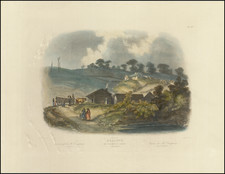One of the Most Iconic Images of Native Americans from the American South.
Tomo Chachi Mico, engraved by Johann Jakob Kleinschmidt after John Verelst, is a dignified representation of Tomochachi, Chief of the Yamacraw, and his nephew Toonahowi. This wonderful and evocative copper engraving documents a 1734 visit to London by the two Native American dignitaries. Tomochichi and his nephew are shown wearing animal skins, with the younger of the two holding a beautiful bald eagle, symbolizing peace in this context. The engraving is one of the most famous portraits of Native Americans from the South and elucidates a noted 18th-century episode of cross-cultural engagement and geopolitical negotiation.
The early 1700s was characterized by the evolving relationships between the indigenous populations of the Americas and the expanding European colonies. Tomochichi, who played a pivotal role in these developments, created his own Yamacraw tribe from an assortment of Creek and Yamasee Indians after the two nations disagreed over future relations with the British and the Spanish. His people, approximately two hundred in number, settled along the Savannah River. Tomochichi's decision to ally with James Oglethorpe, which facilitated the establishment of Savannah, exemplifies the nuanced alliances and conflicts that defined this epoch. His successful negotiation with the Georgia Trustees included demands for Western education for his people and promises of justice in the face of unfair practices of colonial traders. Savannah's Tomochichi Federal Building and U.S. Courthouse was named in his honor.
In this visual representation, Tomochichi and Toonahowi are shown during their sojourn in London. The portrayal is more than a mere aesthetic exercise; it is a document bearing witness to a complex interplay of power and diplomacy. In the grand halls of British governance and ecclesiastical power, Tomochachi articulated demands for education and justice for his people, navigating a landscape of unequal power with strategic acumen.
Like the Indian Kings who visited Queen Anne’s court in 1710, Tomochichi also became the subject of painter John Verelst; but unlike the Mohawk and Machcan diplomats who he presented wearing European finery, the artist chose to portray the Yamacraw leader and his nephew Toonahowi clad in deerskin standing within a dense, primeval forest. The original portrait by Verelst, which hung in the rooms of the Georgia Trustees in London, is believed lost. John Farber made a mezzotint of Verlest’s portrait in 1734, and it is likely that Kleinschmidt quickly issued his version to meet demand. Kleinschmidt 's engraving served as a frontispiece to Vol. 1 of Urlesperger's Ausführliche Nachricht von den Salzburgischen Emigranten, the collected edition of the so-called Salzburger Tracts, though the plate is almost invariably lacking from examples of the publication. The reason for such a German publication about the southern colonies stems from the Salzburg settlers who, fleeing religious persecution in Europe, accepted James Oglethorpe's invitation to settle in Georgia in 1734. At least twelve hundred Salzburgers eventually settled in Georgia.
Verelst’s original portrayal, and Kleinschmidt’s subsequent engraving, make no effort to Europeanize the indigenous visitors. Tomochachi and Toonahowi are depicted in deerskin, situating them firmly within their cultural context, even placing the two figures within an imaginary American forest setting. However, they are not presented as curiosities but as diplomats, engaging with the British on terms that, while imbalanced, allowed for the expression of agency and the articulation of specific political and social objectives.
With the present portrait Kleinschmidt offers not just a visual artifact but a complex historical document. It conveys the multifaceted nature of European-Indigenous relations in colonial America, where power, identity, and culture were subjects of both confrontation and negotiation. This engraving stands as a prime resource for understanding the textured dynamics that informed the colonial period, reflecting the dialogues that, while often fraught, contributed to the shaping of the New World.
Rarity
This engraving is very rare in the market. Only three other examples have appeared in RBH in the last 20 years.









![Mexican Painting. 3776 Codex Vaticanus page 74. Aglio 3rd Vol. called the Little Vatican MS. [on sheet with] Quetzalcoatl Crucified Codex Borgianus...](https://storage.googleapis.com/raremaps/img/small/102318.jpg)
![(Mexican-Aztec Painting) [Watercolor of four Aztec deities from the Codex Telleriano Remensis and Codex Vaticanus]](https://storage.googleapis.com/raremaps/img/small/103011.jpg)
![[ Virginia Natives -- The Conjurer ] Praestigiator](https://storage.googleapis.com/raremaps/img/small/98754.jpg)

![[ Native American about to Murder A Frenchman in a Dugout Canoe ] Petri Gambie Galli Caedes](https://storage.googleapis.com/raremaps/img/small/97871.jpg)
![[ Kealakekua Bay, Hawaii ] Village de Kearakekoua. Iles Sandwich](https://storage.googleapis.com/raremaps/img/small/99764.jpg)